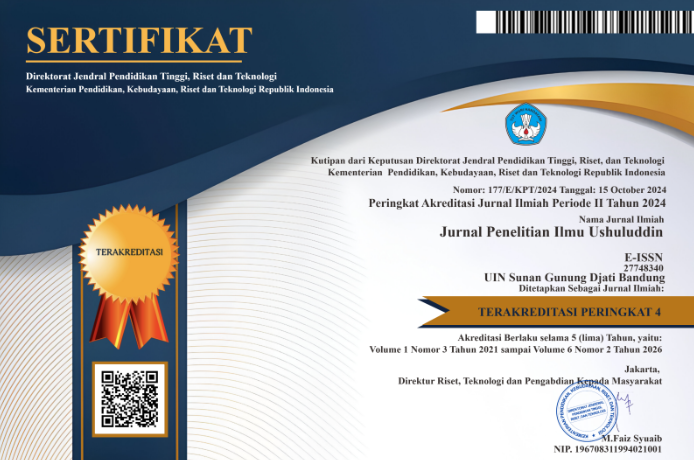Hadis Hijab Pandangan Kontemporer: Studi terhadap Pemahaman Fatima Mernissi, Quraish Shihab, dan Muhammad Syahrur
DOI:
https://doi.org/10.15575/jpiu.13562Keywords:
Contemporary, Hadith, Hijab, Syarah, TakhrijAbstract
This study aims to discuss the hadith about hijab in a contemporary view. This research is a qualitative type through literature study using the takhrij and syarah hadith methods with a contemporary approach. The results and discussion of this research include the definition of hijab, the term hijab in history, the term hijab today, hadith editors about hijab, hijab according to hadith, and hijab in a contemporary view. This study concludes that there is no hadith that states the term hijab as Muslim clothing, and when referring to today's era the term hijab is understood as a means of covering the genitals for women, whether it is a headscarf, headscarf, or clothes. Today's hijab is also understood not only as a tool to cover the genitals but has also developed into fashion (life style).
References
Abdurrahman, A. E. (1990). Murtaá¸Ä Muá¹ahharÄ«, Hijab: Gaya Hidup Wanita Islam. Bandung: Mizan.
al-Asqalani, A.-I. A.-H. (2002). Fathul Baari Syarah Sahih Bukhari Jilid 2. Jakarta: Pustaka Azam.
al-Nawiy, S. R. (2007). Hukum Islam Seputar Busana dan Penampilan wanita, cet 1. Yogjakarta: Ar-Raudhoh Pustaka.
an-Nawaawi, I. (2013). Al-Minhaj Syarah Sahih Muslim Jilid 10. Jakarta: Darus Sunnah.
Asyadily, M. H. (2019). Telaah Kritis Pemahaman Hijab dalam Framework Fatima Mernissi. FIKRAH, 7(2), 303-332.
Ath-Tharifi, A. B. (2015). Hijab Busana Muslimah sesuai Syariat dan Fitrah. Solo: Al-Qowam.
Azis, D. A. (1996). Ensiklopedia Hukum Islam, cet 1. Jakarta: Ichtiar Baru Van Hoeve.
Bakar, R. A. (2019). Hijab dan Jilbab dalam Perspektif Sejarah. AL-IRSYAD, 6(1).
Darmalaksana, W. (2020). Cara Menulis Proposal Penelitian. Bandung: Fakultas Ushuluddin UIN Sunan Gunung Djati Bandung
Darmalaksana, W. (2020). Penelitian Metode Syarah Hadis Pendekatan Kontemporer: Sebuah Panduan Skripsi, Tesis, dan Disertasi. Diroyah: Jurnal Studi Ilmu Hadis, 5(1), 58-68.
Daud, F. K. (2013). Jilbab, Hijab dan Aurat Perempuan (Antara Tafsir Klasik, Tafsir kontemporer dan Pandangan Muslim Feminis). Al Hikmah: Jurnal Studi Keislaman, 3(1), 1-1.
Delimunte, R. (2018). Pengantar Takhrij TMT III. Bandung: Ilmu Hadis Press.
el-Guindi, F. (2003). Jilbab antara Kesalehan Kesopanan dan Perlawanan . Jakarta: Serambi Ilmu Semesta.
Nur‘Afifah, F., & Munandar, S. A. (2020). Konsep Jilbab Masa Klasik-Kontemporer (Studi Komparatif Kitab Tafsir Al-Misbah dan Kitab Tafsīr Al-Kabīr). Refleksi, 19(1).
Halim, C. (2000). Abu Halim Abu Syuqqah, Kebebasan Wanita Jilid 3. Jakarta: Gema Insan Press.
Hariono, D. (2019). Syarah Hadis: Model dan Aplikasi Metodologis. UNIVERSUM: Jurnal KeIslaman Dan Kebudayaan, 13(2).
Hidayatullah, T. I. (2002). Ensiklopedi Islam Indonesia Cet. II. Jakarta: Djambatan.
Husein, M. (2004). Islam Agama Ramah Perempuan. Yogyakarta: LKiS
Daud, F. K. Jilbab, Hijab dan Aurat Perempuan. Jurnal Studi Keislaman.
Khairunnisa, S. (2017). Hijab dalam Konsep Feminisme Fatima Merissi. Jakarta: UIN Syarif Hidayatullah Jakarta
Khoiri, M. A. (2016). Fiqih Busana Telaah Kritis Pemikiran Muhammad Syahrur. Yogyakarta: Kalimedia.
Mahmada, N. D. (2005). Ijtihad Islam Liberal dalam "Kritik atas Jilbab" . Jakarta: JIL.
Marhumah, E. (2014). Jilbab dalam Hadis: Menelusuri Makna Profetik dari Hadis. Musãwa Jurnal Studi Gender Dan Islam, 13(1), 59-72.
Megawati, M. (2012). Hijab dalam Al-Qur'an (Suatu Kajian Tafsir Maudu'i) (Doctoral dissertation, UIN Alauddin Makassar).
Mernnisi, F. (1997). Menengok Kontoversi Peran Wanita dalam Politik, terj. M. Mansyur Abadi. Surubaya: Dunia Ilmu.
Muslih, M. (2017). Mitologi Hijab: Meneropong Pergeseran Makna Hijab sebagai Simbol Keimanan dan Simbol Fashion Era Milenial di Indonesia. JOIES: Journal of Islamic Education Studies, 2(1), 65-86.
Muthahhari, M. (2003). Hijab: Citra Wanita Terhormat. Jakarta: Pustaka Zahra.
Najitama, F. (2014). Jilbab Dalam Konstruksi Pembacaan Kontemporer Muhammad Syahrûr. Musãwa Jurnal Studi Gender Dan Islam, 13(1), 9-18.
Nuroniyah, W. (2017). Dekonstruksi Hijab (Kajian Sosio-Historis terhadap Konstruksi Hukum Hijab dalam Islam). Al-Manahij: Jurnal Kajian Hukum Islam, 11(2), 263-280.
Qasthalani, M. (2017). Konsep Hijab dalam Islam. Nizham Journal Of Islamic Studies, 2(1), 143-157.
Qomarullah, M. (2016). Metode Takhrij Hadits Dalam Menakar Hadits Nabi. El-Ghiroh: Jurnal Studi Keislaman, 11(2), 23-34.
Roziqin, A. K. (2018). Jilbab, Hijab Dan Telaah Batasan Aurat Wanita. Al-Bayan: Jurnal Ilmu al-Qur'an dan Hadist, 1(2), 256-279.
Safri, A. N. (2014). Pergeseran Mitologi Jilbab (Dari Simbol Status ke Simbol Kesalehan/Keimanan). Musãwa Jurnal Studi Gender Dan Islam, 13(1), 19-28.
Sanusi, A. (2014). Takhrij Hadis. Depok: Madani Publishing.
Shahab, H. (2013). Hijab Menurut Al-Qur'an dan Al-sunnah. Bandung: PT Mizan Pustaka.
Shihab, M. Q. (2018). Jilbab Pakaian Wanita Muslimah: Pandangan Ulama Masa Lalu dan Cendekiawan Kontemprer. Tangerang: Lentera Hati.
Sofiyah, A., & Zafi, A. A. (2020). Hijab bagi Wanita Muslimah di Era Modern. Ijtimaiyya: Jurnal Pengembangan Masyarakat Islam, 13(1), 89-102.
Suyadi, M. A. (2008). Ulumul Hadis. Bandung: Pustaka Setia.
Syuqqah, A. a.-H. (1998). Busana dan Perhiasan Wanita Menurut Al-Qurán dan Hadis. Bandung: Mizan.
Wahidah, A. d. (2018). Ensiklopedia Fikih Wanita: Pembahasan Lengkap A-Z Fikih Wanita dalamPadangan Empat Madzhab. Jakarta: PT. Elex Media Komputindo.
Yulikhah, S. (2017). Jilbab antara Kesalehan dan Fenomena Sosial. Jurnal Ilmu Dakwah, 36(1), 96-117.
Zakariya, A. H. (2002). Mu'jam Maqayis Al-Lughah jilid 2. Beirut: Dar al Fikr.
Downloads
Published
Issue
Section
License
Authors who publish in Jurnal Penelitian Ilmu Ushuluddin agree to the following terms:
- Authors retain copyright and grant the journal right of first publication with the work simultaneously licensed under an Attribution-ShareAlike 4.0 International (CC BY-SA 4.0) License that allows others to share the work with an acknowledgment of the work's authorship and initial publication in this journal.
- Authors are able to enter into separate, additional contractual arrangements for the non-exclusive distribution of the journal's published version of the work (e.g., post it to an institutional repository or publish it in a book), with an acknowledgment of its initial publication in this journal.
- Authors are permitted and encouraged to post their work online (e.g., in institutional repositories or on their website) prior to and during the submission process, as it can lead to productive exchanges, as well as earlier and greater citation of published work (See The Effect of Open Access).












